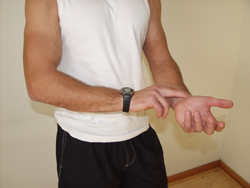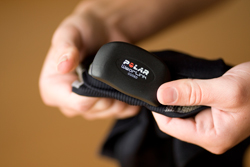
How Measuring Heart Rate Will Help You Crush Your Competition
Posted by Spinning® on Apr 18th 2018
By Chere LucettTo be frank, I’m competitive, maybe too competitive for my own good. I once threw a basketball at my poor husband’s head when we played one-on-one (in all fairness, he was cheating), but the fact remains, I like to compete. However, the competition is best kept within myself (I mean, nobody likes that person, right?). It just isn’t enough to think I am getting faster or stronger (or in better shape). I have to KNOW I am.If you are anything like me, when it comes to measuring performance, subjective “feelings” of performance won’t do. I need to know how hard I am working and what I need to do to work harder. And that’s why I use heart rate monitoring.
Measuring Heart Rate
If you want a decent picture of your cardiovascular fitness and a baseline measurement to compare when you kick your training up a notch, you’ll want to measure heart rate. But first, you’ll need to get a baseline measurement of resting heart rate to determine your appropriate heart rate training zone.The normal resting heart rate (RHR) ranges for adults is from 60-100 beats per minute (BPM) (Mayo Clinic, 2015). A higher RHR may be an indicator of poor cardiovascular fitness, because the heart is required to work harder at rest by contracting more frequently to
 circulate blood throughout the body. A lower RHR may be an indicator of good cardiovascular fitness, because the heart has a more forceful contraction at rest and does not have to work as hard to circulate blood.Heart rate can be recorded on the inside of the wrist (radial pulse). Ideally, to gather the most accurate recording, it’s best to record your resting heart rate upon waking in the morning, prior to coffee (sorry!).
circulate blood throughout the body. A lower RHR may be an indicator of good cardiovascular fitness, because the heart has a more forceful contraction at rest and does not have to work as hard to circulate blood.Heart rate can be recorded on the inside of the wrist (radial pulse). Ideally, to gather the most accurate recording, it’s best to record your resting heart rate upon waking in the morning, prior to coffee (sorry!).
Establishing your training intensity
If you are an internal competitor like me, one thing is for sure, when you train, you want to train harder. You’ll need to establish your ideal training intensity to help you key in on how to improve your fitness. The Karvonen formula, also known as Heart Rate Reserve method, establishes training intensity based on the differences between your predicted maximal heart rate and your resting heart rate.First you’ll find your resting heart rate, as discussed above. Second, you’ll determine your estimated heart rate max using the Age Predicted Heart Rate Max Equation: 208 – (0.7 x age in years) = your heart rate max.An example for someone who is 40 years of age would be:208 – (0.7 x 40) = 180 HRmax
Then pop that info into the Karvonen Formula to determine the training heart rate (THR):
THR = [(HRmax – HRrest) × desired exercise intensity] + HRrestFor example, if you have a RHR (HRrest) of 70 BPM, an estimated maximal HR (HRmax) of 180 with a desired exercise intensity of 85% of HRmax, the THR would be determined as such:THR = [(180– 70) × .85] + 70 = 163 beats/min
How do you know what intensity to shoot for?
Different training zones generally provide different results. For example, if you are looking to perform a more moderate cardiovascular workout, working at 70%-80% of your target heart rate will keep you in the aerobic zone. This zone won’t feel incredibly hard – you’ll feel like you’re working and breaking a sweat, but you’ll be able to hold a conversation. However, if you want to push limits, you are looking to shoot for spending some time in the anaerobic training zone, which is between 80%-90% of your target heart rate. You’ll know you are in this zone when you are finding it difficult to carry one a conversation. The last training zone, often called the redline zone, is the last line where you are working at 90%-100% of your target heart rate. This is an all out sprint to the finish. Just a note of caution, this zone isn’t for everyone and in fact, you want to be careful approaching this zone if you aren’t ready for it. It WILL kick your butt!A combination of working in the aerobic zone, anaerobic zone and the redline zone is ideal to open up your training potential (Gibala & McGee, 2008). But how do you know you’re in the right zone?
Wear a heart rate monitor!
 Techno training today has come so far, many heart rate monitors will do just about everything but pedal for you. Honestly, you don’t need all the fancy doo-dads. You need a very basic heart rate strap and accompanying display watch or monitor on your bike that will let you know your exact heart rate at any given moment. And if you know your zones and what your heart rate should be in each of those zones, you are set.Once you understand your heart rate better, you’ll start to understand a few key items: number one, you’ll know how hard you have to work to get your heart rate in the right zone. The more fit you get, the harder it will be to raise your heart rate and keep it raised. The good news is that you are increasing your anaerobic threshold, burning more calories and becoming more fit. The bad news is that you’ll have to put in more sweat-equity. Second, you will notice how fast your heart rate recovers from the highest levels to moderate and low heart rate levels. That’s a good thing. The faster your heart recovers the better. That means your ticker is pumping efficiently and you’ll be ready for the next sprint in no time.
Techno training today has come so far, many heart rate monitors will do just about everything but pedal for you. Honestly, you don’t need all the fancy doo-dads. You need a very basic heart rate strap and accompanying display watch or monitor on your bike that will let you know your exact heart rate at any given moment. And if you know your zones and what your heart rate should be in each of those zones, you are set.Once you understand your heart rate better, you’ll start to understand a few key items: number one, you’ll know how hard you have to work to get your heart rate in the right zone. The more fit you get, the harder it will be to raise your heart rate and keep it raised. The good news is that you are increasing your anaerobic threshold, burning more calories and becoming more fit. The bad news is that you’ll have to put in more sweat-equity. Second, you will notice how fast your heart rate recovers from the highest levels to moderate and low heart rate levels. That’s a good thing. The faster your heart recovers the better. That means your ticker is pumping efficiently and you’ll be ready for the next sprint in no time.
So how does heart rate help you crush the performance measures from your last ride?
Well it’s simple. The more efficient your heart is pumping, the more oxygen in your blood, the more you are utilizing energy optimally and hence, the more you can out pedal, out sprint and out climb your last performance. Using heart rate training you’ll be able to have an objective number that will tell you if you are slacking (you are in a zone that’s too low to increase your performance) or if you need to hit the brakes because your heart rate is jumping too high for your own good. You’ll also be able to tell if you are overtraining. For example, if your heart rate doesn’t recover as quickly as usual, or it jumps too high too soon (when it normally has a gradual progression upwards) may be indicative of overtraining (Clark, Lucett, & Sutton, 2014). All these factors help you understand your potential and your cardiovascular fitness.
Summary
There are several methods to understanding your performance; heart rate is one of the easiest to integrate into your training sessions (and it’s pretty cost-effective). You’ll know your limits and be able to target your performance to reach better fitness heights if you use it, and you don’t have to be an overly zealous competitor to find it useful.
References
Clark, M.A., Lucett, S.C., & Sutton, B.G. (2014). NASM essentials of personal fitness training (4th ed. revised). Burlington, MA: Jones & Bartlett Learning.Gibla, M.J. & McGee, S.L. (2008). Metabolic adaptations to short-term high-intensity interval training: A little pain for a lot of gain? Exercise and Sport Sciences Review, 36(2), 58-63.Mayo Clinic. (2005). What’s normal resting heart rate? Retrieved from: http://www.mayoclinic.org/healthy-lifestyle/fitness/expert-answers/heart-rate/faq-20057979
